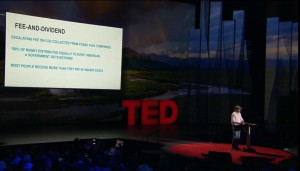 This is the first time I’ve heard a scientist talk really well about the climate change issue. It’s clear that the science behind climate change is sound and we can’t deny it’s truth. Back in the 1980’s I can see how there could have been some doubt, but the last 30 years have seen all of the climate change predictions come true. It’s very clear and very scary.
This is the first time I’ve heard a scientist talk really well about the climate change issue. It’s clear that the science behind climate change is sound and we can’t deny it’s truth. Back in the 1980’s I can see how there could have been some doubt, but the last 30 years have seen all of the climate change predictions come true. It’s very clear and very scary.
James Hansen is probably the strongest voice on climate change. He has worked for NASA and universities, advised governments and given evidence before congress. His message is easy to understand and it’s obvious that we have a big problem and we have to act quickly. However, we’re really not doing anything.
The good news is that if we reduce our CO2 emissions by a bit less than 10% per year, we’ll restore balance to Earth and the warming would stop. So if we can succeed with using 10 percent less, then we can save the planet. Luckily, 10% doesn’t sound too hard, but do we have the will to do it?
I’ve made some detailed notes from this talk and put them below the video here.
Why I must speak out about climate change
My Notes – Why I must speak out about climate change
- It started for him at University when he was studying the planet Venus
- Venus had intense microwave radiation and it turned out that this was because it was very hot
- Venus has a veil of sulfuric acid
- He started on a project to send a probe to study Venus, but then realized that the atmospheric composition of the Earth is changing
- He resigned from the Venus project to study Earth which was a planet changing before our eyes
- The greenhouse effect on Earth has been well understood since about 1850 where they proved that CO2 absorbed heat and acted like a blanket on the Earth
- In 1981, James Hansen (and others) published a paper showing that the 0.4 degrees increase in temperature over the preceding century was consistent with the greenhouse effect caused be increasing levels of CO2
- This paper predicted that Earth would warm in the 1980’s, and warming would exceed the noise level of random variations by the end of the century, and that the 21st century would see shifting climate zones, creation of drought prone regions in North America and Asia, erosion of ice sheets, rising sea levels and open of the north-west passage
- All of these things have happened or are happening
- Global warming causes heat waves and droughts on the one hand directly from the warming as well as stronger storms and greater flooding because a warmer atmosphere holds more water vapor and has more energy
- In the mid 2000’s, James was told by NASA that he was not allowed to speak to the public or the media without explicit approval
- He told the press about these restrictions and that caused them to be lifted
- Adding CO2 to the air is like throwing another blanket on the bed
- There’s a temporary energy imbalance – more energy is coming in (from the sun) than going out, until the Earth warms up enough
- When there’s an imbalance, they Earth will warm up even without adding any more CO2
- They can precisely measure the energy imbalance using the oceans, land masses and ice sheets
- The imbalance right now is equivalent to exploding 400 Hiroshima style atomic bombs per day, every day of the year – that’s how much extra energy the Earth is gaining at the moment
- To stop the imbalance we have to reduce CO2 from 390 ppm (as it was in 2012 – in 2014 it’s 401) back to 350 ppm
- 350 ppm would restore energy balance and prevent further warming
- James thinks that sea-level could rise as much as 5 meters this century, if we continue to burn fossil fuels
- 20-50% of all species could be extinct be the end of this century
- Extreme weather events now affect about 10% of the Earths surface whereas 50 years ago this was less than 0.3%
- He proposes a fee on carbon emission and dividend system to solve the problem – he has some top economists as co-authors of the proposition
- Instead, governments are forcing the public to subsidize fossil fuels
- This path guarantees that we will pass tipping points
- The problem is equivalent to having a giant asteroid heading towards Earth
- If we’d started in 2005, we’d have need 3% per year reduction in emissions to restore balance
- If we start in 2013, it’s 6% per year that’s needed
- If we wait until 2022, it will be 15% per year that’s required – that would be very difficult and perhaps impossible
- But we haven’t even started
Leave a Reply